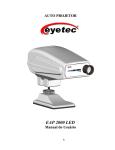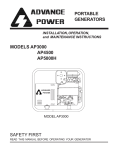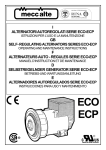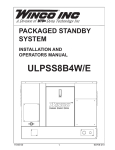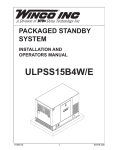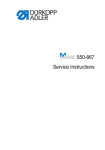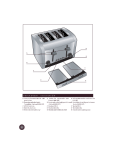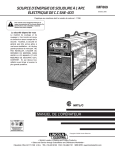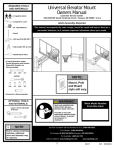Download Briggs & Stratton 18000 Operating instructions
Transcript
CHASSIS MOUNTED GENERATOR EC18000/A EC22000/A INSTALLATION AND OPERATORS MANUAL WINCO INC. 225 S. CORDOVA AVE. LECENTER, MN 56057 507-357-6821 SERVICE DEPT. 507-357-6831 SAVE THESE INSTRUCTIONS This manual contains important instructions that should be followed during installation and maintenance of the generator and battery. Read and understand all instructions in the manual before starting and operating the generator set. USING THE MANUAL Congratulations on your choice of a Winco generator set. You have selected a high-quality, precision engineered generator set designed and tested to give you years of satisfactory service. To get the best performance from your new engine generator set, it is important that you carefully read and follow the operating instructions in this manual. Should you experience a problem please follow the “Troubleshooting Hints” near the end of this manual. The warranty listed in the manual describes what you can expect from WINCO should you need service assistance in the future. COPY YOUR MODEL AND SERIAL NUMBER HERE No other WINCO generator has the same serial number as yours. It is important that you record the number and other vital information here. If you should ever need to contact us on this unit it will help us to respond to your needs faster. MODEL__________________________________ SERIAL NUMBER_________________________ PURCHASE DATE_________________________ DEALER_________________________________ DEALER PHONE # ________________________ TABLE OF CONTENTS INTRODUCTION i SAFETY INFORMATION1 UNIT SPECIFICATIONS 2 UNIT CAPABILITIES 2 PREPARING THE UNIT Unpacking the Unit 3 INSTALLATION 4 Ventilation 4 Gas Supply 4 Lubrication 5 Battery Installation 5 INITIAL START UP 5 Basic Operation 6 CONNECTING The LOADS 7 ENGINE CARE 8 GENERATOR CARE 8 TROUBLESHOOTING 9 EC18000 OUTLINE DWG10 EC22000 OUTLINE DWG11 OPTION FUEL TANK INSTALLATION12 WARRANTY INFORMATION18 PROPER USE AND INSTALLATION You must be sure your new engine generator set is: * Properly serviced before starting. * Operated in a well ventilated area. * Properly exhausted and gases safely dispersed. * Operated only for its designed purposes. * Used only by operators who understand its operation. * Properly maintained. SAFETY INFORMATION 2. FIRE HAZARD - Gasoline and other fuels present a hazard of possible explosion and/or fire. This engine generator set has been designed and manufactured to allow safe, reliable performance. Poor maintenance, improper or careless use can result in potentially deadly hazards; from electrical shock, exhaust gas asphyxiation, or fire. Please read all safety instructions carefully before installation or use. Keep these instructions handy for future reference. Take special note and follow all warnings on the unit labels and in the manuals. a. Do not refuel when the engine is running or hot. b. Keep fuel containers out of reach of children. c. Do not smoke or use open flame near the generator set or fuel tank. d. Keep a fire extinguisher nearby and know its proper use. Fire extinguishers rated ABC by NFPA are appropriate. e. Store fuel only in an approved container, and only in a well ventilated area. ANSI SAFETY DEFINITIONS *********************************************************** 3. DEADLY EXHAUST GAS - Exhaust fumes from any gasoline engine contain carbon monoxide, an invisible, odorless and deadly gas that must be mixed with fresh air. DANGER: DANGER indicates an imminently hazardous situation which, if not avoided, will result in death or serious injury. This signal word is to be limited to the most extreme situations. *********************************************************** a. Operate only in well ventilated areas. b. Never operate indoors. c. Never operate the unit in such a way as to allow exhaust gases to seep back into closed rooms (i.e. through windows, walls, floors). *********************************************************** WARNING: WARNING indicates a potentially hazardous situation which, if not avoided, could result in death or serious injury. *********************************************************** 4. NOISE HAZARD - Excessive noise is not only tiring, but continual exposure can lead to loss of hearing. a Use hearing protection when working around this equipment for long periods of time. b. Keep your neighbors in mind when using this equipment. *********************************************************** CAUTION: CAUTION indicates a potentially hazardous situation which, if not avoided, may result in minor or moderate injury. It may also be used to alert against unsafe practices. *********************************************************** 5. CLEANLINESS - Keep the generator and surrounding area clean. a. Remove all grease, ice, snow or materials that create slippery conditions around the unit. b. Remove any rags or other materials that could create a potential fire hazard. c. Carefully clean up any gas or oil spills before starting the unit. NOTE: CAUTION is also used on the unit labels and in this manual to indicate a situation that could result in serious damage or destruction of the equipment and possible personal injury. 1. ELECTRICAL SHOCK - The output voltage present in this equipment can cause fatal electric shock. This equipment must be operated by a responsible person. 6. SERVICING EQUIPMENT All service, including the installation or replacement of service parts, should be preformed only by a qualified technician. a. Use only factory approved repair parts. b. Do not work on this equipment when fatigued. c. Never remove the protective guards, covers, or receptacle panels while the engine is running. d. Use extreme caution when working on electrical components. Voltage from this equipment can cause serious injury or death. e. Always avoid hot mufflers, exhaust manifolds, and engine parts. They can cause severe burns instantly. f. The use of the engine-generator set must comply with all national, state, and local codes. a. Do not allow anyone to operate the generator without proper instruction. b. Guard against electric shock. c. Avoid contact with live terminals or receptacles. d. Use extreme care if operating this unit in rain or snow. e. Use only three or four pronged grounded receptacles and extension cords. f. Be sure the unit is properly grounded in accordance withapplicable codes. 60706-231 12124-00 UNIT SPECIFICATIONS MODEL Complete Unit Weight (dry) Dimensions LxWxH EC18000VE/A Owner Must Provide Fuel Supply Gasoline Including Tank & Lines Oil Type SG SF, SH, SJ or higher Oil Weight (general use) Synthetic 5W-30 See engine manual for additional information Oil Capacity 2.5 Quarts Generator Mecc Alte Spa Model Number S20F-230/A, Surge Watts18000 Continuous Watts15000 Volts120/240 AMPs @ 240 Volts 62.5 AMPs @ 120 Volts125 TESTING POLICY Engine Briggs & Stratton Size 895 cc/OHV Horse Power 31 Model 543477 Type - 2141 G1 Fuel Consumption Gasoline 2.7 gal/hr Starting System Electric Key Start Voltage12V Low Oil Protection Standard Complete Unit Weight (dry) Dimensions LxWxH Before any generator is shipped from the factory, it is fully checked for performance. The generator is loaded to its full capacity, and the voltage, current and frequency are carefully checked. Rated output of generator is based on engineering tests of typical units, and is subject to, and limited by, the temperature, altitude, fuel, and other conditions specified by the manufacturer of the applicable engines. 326 LBS 34” X 21.2 x 24.1 UNIT CAPABILITIES Owner Must Provide Fuel Supply Gasoline Including Tank & Lines Oil Type SG SF, SH, SJ or higher Oil Weight (general use) Synthetic 5W-30 See engine manual for additional information Oil Capacity 2.5 Quarts MODEL GENERATOR CONNECTIONS The diagram below represents the 15,000 watt generator. The capability of the unit is shown as follows: “A” and “B” represent the 120 volt capability of the generator in this case 7500 watts between both G1 to neutral and G3 to neutral. “C” represent the 240 volt capability of the generator, 15000 watts between G1 and G3. This generator produces 120 and 240 volt, 60 Hz (Hertz), AC (Alternating Current). EC22000VE/A Generator Mecc Alte Spa Model Number ECP28-2L/2, Surge Watts 22000 Continuous Watts19000 Volts120/240 AMPs @ 240 Volts 79 AMPs @ 120 Volts158 Check the appliance or tool nameplates for the current and voltage to ensure compatibility. Remember that power utilized from C reduces the power available at both A and B and vice versa. The EC22000 utilizes the same format with “A” & “B” being 9500 watts and “C” being 19,000 watts Engine Briggs & Stratton Size 993 cc/OHV Horse Power 35 Model 613477 Type - 0219 G1 Fuel Consumption Gasoline 3.3 gal/hr Starting System Electric Key Start Voltage12V Low Oil Protection Standard 12124-00 495 LBS 38” X 20.7 x 24.6 60706-231 STARTING ELECTRIC MOTORS The heavy surge of current required for starting motors is required for only an instant. The generator will not be damaged if it can bring the motor up to speed in a few seconds of time. If difficulty is experienced in starting motors, turn all other electrical loads off and if possible reduce the load on the electric motor. Electric motors require much more current (amps) to start them than to run them. Some motors, particularly low cost split-phase motors, are very hard to start and require 5 to 7 times as much current to start them as to run them. Capacitor motors are easier to start and usually require 2 to 4 times as much current to start them as to run them. Repulsion Induction motors are the easiest to start and require 1 1/2 to 2 1/2 times as much to start them as to run them. PREPARING THE UNIT UNPACKING Most fractional horsepower motors take about the same amount of current to run them whether they are Repulsion Induction (RI), Capacitor (Cap), or Split-Phase (SP) type. The chart below shows the approximate current required to start and run various types and sizes of 120 volt 60 cycle electric motors under average load conditions. HP AMPS RUNNING CAUTION: EQUIPMENT DAMAGE THIS UNIT HAS BEEN SHIPPED WITHOUT OIL. Failure to maintain the engine oil at the proper level will result in serious engine damage. When you unpack your new engine-generator set be sure to remove all the information sheets and manuals from the carton. STARTING AMPS SP CAP 1. This generator-set was in good order when shipped. Inspect the generator-set promptly after receiving it. If any damage is noted, notify the transportation company immediately; request proper procedures for filing a “concealed damage” claim. Title to the equipment and responsibility for filing a claim rests with you when a generator-set is sent F.O.B. shipping point. Only you can legally file a claim. RI 1/6 3.2 16 to 22 6 to 13 5 to 8 1/4 4.5 22 to 32 9 to 18 7 to 12 1/3 5.2 26 to 35 10 to 21 8 to 17 1/2 7.2 not made 14 to 29 11 to 18 1 13.0 not made 26 to 52 20 to 33 The figures given above are an average load such as a blower or fan. If the electric motor is connected to a hard starting load such as an air compressor, it will require more starting current. If it is connected to a light load, or no load such as a power saw, it will require less starting current. The exact requirement will also vary with the brand or design of the motor. 2. Before proceeding with the preparations of your new generator-set for operation, take a couple of minutes to ensure the unit you have received is the correct model and review the specification pages in this manual to ensure that this unit meets your job requirements. Self-exciting generators respond to severe overloading differently than utility power. When overloaded, the engine is not able to supply enough power to bring the electric motor up to operating speed. The generator responds with high initial starting current, but the engine speed drops sharply. The overload may stall the engine. If allowed to operate at very low speeds, the electric motor starting winding will burn out in a short time. The generator winding might also be damaged. CAUTION: EQUIPMENT DAMAGE RUNNING THE GENERATOR SET UNDER THESE CONDITIONS MAY RESULT IN DAMAGING THE GENERATOR STATOR AS WELL AS THE MOTOR WINDING. 60706-231 12124-00 GASOLINE INSTALLATION AND UNIT PREPARATION When using gasoline always use a good grade of unleaded fuel. This engine is certified to operate on unleaded gasoline with a pump octane rating of 86 or higher. Gasoline containing no more than 10% ethanol (E10) or 5% methanol by volume may be used. In addition methanol must contain co-solvents and corrosion inhibitors. Use of fuels with content of ethanol or methanol greater than shown above may cause starting and/or performance problems. Always ensure that the fuel is clean and free of all impurities. It is the customer’s responsiblilty to ensure that all installations comply with all local, state and national codes, including OHSA, EPA and NEC. CAUTION EQUIPMENT DAMAGE These units must be mounted on a solid surface to prevent the unit from vibrating and causing damage to the engine or generator. WARNING: FIRE DANGER Gasoline and its fumes are VERY explosive when proper precautions are not taken. Before beginning the installation process recheck the rating of the generator to be certain it can handle the intended load. Plans for installation should be prepared with proper attention to mechanical and electrical engineering detail to assure a satisfactory system installation. The information in this manual is offered only as a guide to finalizing your installation plans. As each installation is different no specifics are provided in this manual Never use gasoline that has been stored for an extended period of time as the fuel will lose its volatile properties and you will be left with only the varnish residue. This varnish like substance will clog the carburetor and will not burn properly. The use of fuel additives, such as STA-BIL, or an equivalent will minimize the formation of fuel gum deposits. If a unit has been out of operation for an extended period of time it is best to drain old fuel from the engine and replace with fresh fuel before attempting to start. VENTILATION These engine generator sets use large amounts of fresh air for cooling. When designing plans for your installation special attention must be paid to the flow of hot air from both the engine and the generator. Both the engine and the generator must be supplied with a constant flow of fresh air from the outside to ensure they don’t overheat. Some provision must be made to remove the hot air out of the enclosure. Ambient temperature around the unit should not exceed 1220F. Engine or generator failures resulting from inadequate ventilation are considered abuse and not covered by the generator or engine manufacturer’s warranty. These units have been designed and shipped without fuel tanks. This allows the customer to utilize whatever size and type of tank they may desire, with some limitations. 1. The fuel lift from the bottom of the tank to the fuel inlet on the generator must not exceed 3 feet. If a greater lift is required it may be necessary to provide an additional electric fuel pump to ensure the engine gets a sufficient flow of fuel. 2. Some states require the installation of a carbon canister on the tank vent line. This is to prevent the escape of fuel vapors in to atmosphere. The engine exhaust from this engine must be vented to the outside. When venting hot exhaust through any type of flammable wall be sure to use exhaust thimbles to prevent fires. 3. You need to have is a primer bulb in the fuel line to prime the fuel from the tank to the fuel pump. The vacuum fuel pump on the engine will not draw the fuel up from the tank until the line has been properly primed. WARNING: PERSONAL INJURY Failure to properly vent the exhaust out of an enclosure can and will kill you. Carbon monoxide is both invisible and orderless and can build up very rapidly in any enclosure not properly vented. 12124-00 4. In all cases the minimum fuel line size must be 1/4” or larger line. And the fuel line must be certified for use with unleaded gasoline. 60706-231 LUBRICATION BATTERY CHARGING Before starting the engine, fill the crankcase to the proper level with a good quality oil. The recommended grade of oil and quantity of oil required is listed in the engine operator’s manual. The necessity of using the correct oil and keeping the crankcase full cannot be overemphasized. Engine failures resulting from inadequate or improper lubricant are considered abuse and not covered by the generator or engine manufacturer’s warranty. Units equipped with electric start have a small flywheel charger built into the engine flywheel assembly for recharging the starting battery. This flywheel charger generates a small AC current that passes through a diode assembly to produce a DC charging current of about 1 to 3 AMPS. This circuit is not designed to be used as a battery charging circuit to recharge dead batteries. OIL ALERT SYSTEM BATTERY INSTALLATION These engine generator sets come equipped standard with the Briggs & Stratton low oil pressure shutdown system. The low oil shutdown system is designed to prevent severe damage caused by an insufficient amount of oil in the crankcase. However if the unit is repeatedly allowed to shutdown on low oil pressure progressive damage will be done to the engine shortening the engine’s life. The engine switch will remain in the “ON” position when the unit is shutdown by the low oil pressure system. You will need to connect this unit to a battery to operate it. Cables have not been provided as length are going to vary depending on your installation. These engines are all negative ground. The positive battery cable must be connected to the open large terminal on the start solenoid (This terminal may have a small 16 GA. wire on it for the charging circuit). The negative cable should be attached to a good ground on the engine. This is usually one of the starter mounting studs. INITIAL START UP A twelve volt battery, rated at 300 CCA or larger is recommended for this electric start engine generator set. Follow the battery manufacturer’s recommendations for servicing and charging prior to use. The throttle control on these generators is preset and locked to operate at 3600 RPM (nominal) with no load speed set at 3690 RPM. Only a trained service technician should be allowed to adjust this speed setting. CAUTION: EQUIPMENT DAMAGE These electric start engines are NEGATIVE GROUND. Use extreme caution when connecting the battery. Connect the NEGATIVE battery terminal to GROUND. NOTICE: ENGINE START LOCKOUT This unit will not start and run if it is low on oil. The lubricating oil level must be at the full mark before the engine will start and run. For your safety always connect the positive battery cable to the “BAT+” terminal first. Then connect the negative battery cable to the “BAT-” terminal. Make sure all connections are clean and tight. Reverse the sequence when disconnecting, disconnect the negative cable first. These engines produce enough direct current to keep a battery charged under normal operating conditions, but were not intended to be used as a battery charger. WARNING: PERSONAL INJURY Lead acid batteries produce explosive hydrogen gas when charging. Keep sparks, flames, and burning cigarettes away from the battery. Ventilate the area when charging or using the battery in an enclosed space. Lead acid batteries contain sulfuric acid, which causes severe burns. If acid contacts eyes, skin or clothing, flush well with water. For contact with eyes, get immediate medical attention. 60706-231 12124-00 BASIC OPERATION STOPPING AND STORAGE ELECTRIC STARTING Turn the key to “OFF” position. Before extended storage (over 30 days) certain precautions must be taken to ensure the fuel doesn’t deteriorate and clog the fuel system. Note: The use of a fuel additive, such as STA-BIL or an equivalent will minimize the formation of gum deposits during storage. Such an additive may be added to gasoline in the engine’s fuel tank or to gasoline in a storage container. If you are going to store the unit for a long period of time we recommend the following steps be taken. CAUTION: EQUIPMENT DAMAGE Always start the unit with the circuit breaker open, never start with the load applied.Always keep the battery charged, especially during cold weather operation. 1. Turn on the fuel supply. 1. Remove the remaining fuel from the fuel tank 2. Using the primer bulb, make sure that the fuel is pumped up to the fuel pump on the engine. 2. Start the engine and allow it to run until all the fuel in the carburetor and the fuel lines has been used up and the engine stops. 3. Move the choke to the full “ON” position for starting. A warm engine will require less choking than a cold engine. 3. While the engine is warm, drain the oil and refill with fresh oil. 4. Turn the key to the start position. The starter life is improved by using shorter starting cycles with time to cool off between cranking cycles. Do not operate the starter more than 15 seconds during each minute. Repeat if necessary. 4. Remove the spark plug, pour approximately 1/2 ounce (15 cc) of engine oil into the cylinder and crank slowly to distribute the oil. Replace the spark plug. 5. When the engine starts, release the key and open the choke gradually. 5. Clean dirt and chaff from cylinders, cylinder head fins, blower housing, screen and muffler areas. Store in a clean and dry area. 6. The engine should promptly come up to operating speed. OPERATING SPEED CAUTION: EQUIPMENT DAMAGE The engine-generator must be run at the correct speed in order to produce the proper electrical voltage and frequency. Never permit the choke to remain on after the engine has run for a short time. It is not necessary to choke the engine when it is warm. Avoid over-choking. CAUTION: EQUIPMENT DAMAGE STARTING HINTS The output voltage should be checked to ensure the generator is working properly prior to connecting a load to the generator. Failure to do so could result in damage to equipment plugged into the unit and possible injury to the individual. 1. Cold weather a. Use the proper oil for the temperature expected. b. Use fresh winter grade fuel. Winter grade gasoline is blended to improve starting. Do not use summer gasoline. All engines have a tendency to slow down when a load is applied. When the electrical load is connected to the generator, the engine is more heavily loaded, and as a result the speed drops slightly. This slight decrease in speed, together with the voltage drop within the generator itself, results in a 2. Hot weather a. Use the proper oil for the temperature expected. b. Use only summer blended gasoline. Using gasoline left over from winter may cause the unit to vapor lock. 12124-00 60706-231 CONNECTING THE LOADS slightly lower voltage when the generator is loaded to its full capacity than when running no load. The slight variation in speed also affects the frequency of the output current. This frequency variation has no appreciable effect in the operation of motors, lights and most appliances. However, electronic equipment and clocks will be affected if correct RPM is not maintained. See Load vs. Output chart. CAUTION: EQUIPMENT DAMAGE Failure to properly limit and balance the load applied to the generator will cause the generator to produce low voltage and may damage the engine generator set. It may also cause severe damage to the loads connected to the generator at that time. Improper loading of the generator set constitutes abuse and will not be covered by warranty. Although individual units and models vary slightly, the normal voltage and frequency of the engine-generator described in this manual are approximately as follows, under varying loads: A 60 amp receptacle (NEMA 14-60) has been provided to allow the connection of loads to the generator on the EC18000. This receptacle is a 4 wire full load receptacle protected by a 60 amp breaker mounted in the control box on top of the generator. LOAD VS. OUTPUT Generator Load Speed (RPM) Frequency (Hz) Voltage None 3690 61.5 125V Half 3600 60.0 120V Full 3510 58.5 115V On the EC22000 the load wiring must be wired directly in the 80 amp breaker mounted in the control box on the top of the generator When wiring directly to the circuit breaker in the box be sure to connect a neutral wire and ground wire to the appropriate locations in the control box. The speed of the engine was carefully adjusted at the factory so that the generator produces the proper voltage and frequency. For normal usage, the speed setting should not be changed. If the generator is being run continuously on a very light load, it is often advisable to lower the operating speed slightly. Whenever making any speed adjustments check the unit with a voltmeter or tachometer and be sure the speed is correct. Your individual loads must be protected by individual circuit breakers mounted in some type of distribution panel. This location will also be where you will install your neutral to ground bond. You must wire four separate wires from the generator (2 -hot,1- neutral and 1-ground) to the distribution panel. Lower voltage may damage both the generator and any load connected to it. Running the engine at excessively high speeds results in high voltage, which may significantly shorten the life of appliances being used. APPLYING THE LOADS Allow the engine to warm up for two or three minutes before applying any load. This will allow the engine to reach normal operating temperature and oil to circulate throughout the engine. A short warm-up time will permit the engine to work more efficiently when the load is applied and will reduce the wear in the engine, extending its life. Output voltage should be checked periodically to ensure continued proper operation of the generating plant and appliances. If the generator is not equipped with a voltmeter, it can be checked with a portable meter. Frequency can be checked by using an electric clock with a sweep second hand. Timed against a wrist watch or a stop watch, the clock should be correct within +/- 2 seconds per minute. If a large motor is being started or multiple motors are being started, they should be started individually and the largest should be started first. CAUTION: EQUIPMENT OVERLOAD Keep the generator load within the generator and receptacle nameplate rating. Overloading may cause damage to the generator and/or the loads . Most electric tools and appliances will have the voltage and amperage requirements on their individual 60706-231 12124-00 nameplates. When in doubt consult the manufacturer or a local electrician. The nameplate amperage rating for electric motors can be misleading. See “Starting Electric Motors” in Unit Capabilities (page 4). 3. Dual Element Air Filter: Clean and/or replace foam pre-cleaner and air filter every 12 months or 100 hours. Service more often under dusty conditions. a. Loosen screws and remove cover and air cleaner assembly from base. b. Remove foam pre-cleaner by sliding it off the paper cartridge. c. Wash foam pre-cleaner in liquid detergent and water. d. Wrap foam pre-cleaner in cloth and squeeze dry. e. Saturate foam pre-cleaner in engine oil. Squeeze to remove excess oil. f. Clean Air filter. g. Install foam pre-cleaner over air filter. h. Re-install the Air Filter assembly. Reassemble cover and screw down tight. These engine-generator sets are inherently self regulating based on engine speed. The engine governor will automatically adjust itself to the load. No harm to the generator will result if it is operated with no load connected. The generator is a limited source of electrical power, therefore pay special attention to the generator ratings. GROUNDING All units must be properly grounded. Different installations will require different grounding requirements. Depending on your installation ensure that the ground meets your governing codes. Do not use petroleum solvents, such as kerosene, to attempt to clean the cartridge. They may cause deterioration of the cartridge. DO NOT OIL CARTRIDGE. DO NOT USE PRESSURIZED AIR TO CLEAN OR DRY CARTRIDGE. ENGINE CARE If major engine service or repair is required contact an authorized engine service center. The manufacturer of these engines has established an excellent world-wide engine service organization. Engine service is very likely available from a nearby authorized dealer or distributor. Check the yellow pages of your local telephone directory under “Engines-Gasoline” for the closest engine repair center or ask the dealer from whom you purchased the power plant. 4. Spark Plug: Clean and reset gap at .030” every 12 months or 100 hours of operation. Do not blast clean spark plug. Clean by scraping or wire brushing and washing with a commercial solvent. Poor spark will occur if terminal does not fit firmly on spark plug. If this happens reform the terminal to fit firmly on spark plug tip. 1. Change the oil after the first month or 5 hours of operation and every 12 months or 100 hours thereafter under normal operating conditions. Change engine oil every 50 hours of operation if the engine is operated under heavy load, or in high ambient temperatures. a. Remove oil drain plug at base of the engine and drain the oil with the engine warm. b. Replace oil drain plug. c. Remove oil filler plug and refill with new oil. Refer to the table in the engine manual for the proper grade of oil based on your operating temperature. d. Replace filler plug. 5. Carbon Canister: Designed to collect, store, and dispose of fuel vapors created in the fuel tank / fuel system. Remove and clean or replace the filter on the canister when maintaining your air filter. The canister will last the life of the unit. GENERATOR CARE Proper care and maintenance of the generator is necessary to ensure a long trouble free life. 1. Exercising The Generator - The generator should be operated every three to four weeks. It should be operated for a period of time sufficient to warm the unit up and to dry out any moisture that has accumulated in the windings. If left, this moisture can cause corrosion in the winding. Frequent operation of the engine generator set will also ensure that the set is operating properly should it be needed in an emergency. 2. Checking the Oil Level: The oil level must always be checked before the engine is started. Take care to remove any dirt or debris from around the oil fill plug before removing. Be sure the oil level is maintained. Fill to the “FULL” mark on the dipstick. 12124-00 60706-231 2. Generator Maintenance - Any major generator service including the installation or replacement of parts should be performed only by a qualified electrical service technician. USE ONLY FACTORY APPROVED REPAIR PARTS. TROUBLESHOOTING HINTS a. b. PROBLEM (SYMPTOMS) POSSIBLE CAUSES ——————————————————————— Won’t Start *Low Oil Level. *Fouled spark plug. *Out of fuel. *Start switch in Off position. ——————————————————————— Voltage too low *Engine speed is too low. *Generator overloaded. *Defective stator. *Defective rotor (field). ——————————————————————— Circuit Breaker *Defective load. Trips *Defective receptacle. ——————————————————————— Voltage too high *Engine speed is too high. ——————————————————————— Generator *Overloaded. overheating *Insufficient ventilation. ——————————————————————— No output voltage *Short in load (disconnect). *Broken or loose wire. *Defective receptacle. *No residual magnetism (in generator). *Defective stator. *Defective rotor (field). *Shorted capacitor. *GFCI Receptacle tripped. ——————————————————————— Bearing - The bearing used in these generators is a heavy duty double sealed ball bearing. They require no maintenance or lubrication. Receptacles - Quality receptacles have been utilized. If a receptacle should become cracked or otherwise damaged, replace it. Using damaged or cracked receptacles can be both dangerous to the operator and destructive to the equipment. CLEANING Remove dirt and debris with a cloth or brush. DO NOT use high pressure spray to clean either the engine or the generator. This high pressure spray could contaminate the fuel system and the generator components. 1. Keep the air inlet screen on both the engine and generator free of any dirt or debris to ensure proper cooling. At least yearly remove the blower housing on the engine and clean the chaff and dirt out of the engine cooling fins and flywheel. Clean more often if necessary. Failure to keep these areas clean may cause overheating and permanent damage to the unit. 2. Periodically clean muffler area to remove all grass, dirt and combustible debris to prevent a fire. 3. On engine mufflers equipped with spark arresters, the spark arrester must be removed every 50 hours for cleaning and inspection. Replace if damaged. 60706-231 12124-00 EC18000VE/A OUTLINE DRAWING 60706-231 10 12124-00 60706-231 11 12124-00 EC22000VE/A OUTLINE DRAWING INSTALLATION INSTRUCTIONS OPTIONAL FUEL TANK KIT EC18000VE & EC22000VE 3 2 1 4 5 COMPONENT LIST REF. # 1 2 3 4 5 NOT SHOWN PART # 81900-001 80900-000 16316-001 62397-001 62391-000 19018-411 DESCRIPTION Carbon Canister Bracket Carbon Canister 15 Gallon Fuel Tank Fuel Cap with Gauge Primer Bulb Bag of Parts QTY. 1 1 1 1 1 1 CUSTOMER SUPPLIED 1/4” AND 5/16” FUEL HOSE CONNECTED TO THE FUEL TANK IS NOT PROVIDED IN THIS KIT. 12124-00 12 60706-231 STEP 1 • Account for all components, hardware and fasteners. FASTENERS & MISC. COMPONENTS (not shown in actual size) 6 7 11 8 14 13 12 9 15 10 HARDWARE & FASTENER LIST REF # PART # DESCRIPTION QTY 6 40078-000 1/4” Fuel Hose 36” 7 40077-000 3/16” Fuel Hose 34” 8 62999-004 Black Hose Clamp .69” OD 4 9 62999-001 Red Hose Clamp .5”OD 4 10 62999-005 Green Hose Clamp .41” OD 3 11 98435-001 Hose Fitting Elbow 1 12 62409-000 Bushing 1 13 62173-001 5/16” Self-Tapping Screw 2 14 98590-003 1/8” - 5/16” X 1/4” - 7/16” Hose Reducer 1 15 40079-000 5/16” Fuel Hose 8” 60706-231 13 12124-00 STEP 2 • • Attach the carbon canister bracket (ref. 1) using the two self-tapping screws (ref.13) Slide the carbon canister (ref. 2) up into the carbon canister bracket (ref.1) and then slide it down until it is locked in place. STEP 3 • • • Mount fuel tank (ref. 3) in a suitable location to ensure proper flow of fuel. The fuel tank must be mounted to a bracket to allow access to the shut-off valve. Bolt holes are provided on the bottom of the fuel tank for mounting to a stable structure. Use 3/8-16 X ? bolts. The length will vary depending on the mounting structure. NOTE: When mounting the fuel tank below the level of the engine an additional fuel pump may be required for a lift of 3 feet or more from the bottom of the fuel tank to the fuel pump on the engine. Hose lengths may have to be adjusted for your application. Install bushing (ref. 12) and hose fitting elbow (ref. 11) into the top of the fuel tank. Install fuel cap with gauge (ref.4) on top of the fuel tank. 12124-00 14 60706-231 STEP 4 • • Route customer supplied 1/4” fuel line from fuel tank to engine and attach the fuel line to the primer bulb (ref. 5) with red hose clamps. Attach 1/4” fuel hose (ref. 6) to the other side of the primer bulb (ref. 5) with red hose clamp (ref. 9) and route to the fuel filter (ref. A) on the engine. See step 5 below. Attach 1/4” fuel hose (ref. 6) to the fuel filter (ref. A) on the engine using red hose clamp (ref. 9). STEP 5 • • • Below is your fuel supply connection point on the engine. Fuel filter (ref. A) is where you connect the fuel line (ref. 6) from Step 4. NOTE: Each installation may vary. Your fuel line lengths may vary depending on your installation requirements. DANGER: Do not allow fuel lines to lay directly on “HOT” surfaces! This may cause a fire. A 60706-231 15 12124-00 STEP 6 • Locate the small plastic bag that came with the Briggs & Stratton engine operators manual. You will use the plastic connector (ref. B) in step 6. You can discard the other part as it is not needed in this application. B STEP 7 • • • Slide black hose clamps (ref. 8) onto 5/16” fuel hose (ref. 15) by compressing them with a pliers. Push hose (ref. 8) onto carbon canister nipple marked PURGE and move the clamp into position at the end of the hose. Twist and push hose reducer (ref. 14) onto hose (ref. 15) and move clamp into position at the end of the hose. NOTE: You can use a small amount of vegetable oil on the hoses to ease in their connection. Repeat process for 3/16” hose (ref. 7). This will connect to the engine hose in step 8. 14 10 B 10 8 8 7 15 2 12124-00 16 60706-231 STEP 8 • • • • Locate the hose (ref. C) on the left side of the engine that has a plastic ball inserted in the end of it. Use a small screw driver to remove the ball. Slide green hose clamp (ref. 10) over hose (ref. C) using a pliers. Route hose assembly (built in step 7) from the carbon canister (ref. 2) to this hose and insert the connector (ref. B) into hose (ref. C). Slide green hose clamp down to the end of the hose clamping it to the connector (ref. B). C STEP 9 • • Attach customer supplied 5/16” fuel hose to hose fitting elbow (ref. 11) on top of the fuel tank. See step 4 for illustration. Route hose (ref. D) to the carbon canister (ref. 2) and connect to the nipple marked TANK using black hose clamp (ref. 8). 60706-231 17 12124-00 24 MONTH LIMITED WARRANTY WINCO, Incorporated warrants to the original purchaser for 24 months that goods manufactured or supplied by it will be free from defects in workmanship and material, provided such goods are installed, operated and maintained in accordance with WINCO written instructions. WINCO’s sole liability, and Purchaser’s sole remedy for a failure under this warranty, shall be limited to the repair of the product. At WINCO’s option, material found to be defective in material or workmanship under normal use and service will be repaired or replaced. For warranty service, return the product within 24 months from the date of purchase, transportation charges prepaid, to your nearest WINCO Authorized Service Center or to WINCO, Inc. at LeCenter Minnesota. THERE IS NO OTHER EXPRESS WARRANTY. To the extent permitted by law, any and all warranties, including those of merchantability and fitness for a particular purpose, are limited to 24 months from date of purchase. In no event is WINCO liable for incidental or consequential damages. Note: Some states do not allow limitation on the duration of implied warranty and some states do not allow the exclusion or limitation of incidental or consequential damages, so the above limitations may not apply in every instance. This warranty gives you specific legal rights which may vary from state to state. WINCO reserves the right to change or improve it products without incurring any obligations to make such changes or improvements on products purchased previously. EXCLUSIONS: WINCO does not warrant Engines. Engines are covered exclusively by the warranties of their respective manufacturers. WINCO does not warrant Batteries, or Other Component Parts that are warranted by their respective manufacturers. WINCO does not warrant modifications or alterations which were not made by WINCO Inc. WINCO does not warrant products which have been subjected to misuse and/or negligence or have been involved in an accident. This warranty does not include travel time, mileage or labor for removal or reinstallation of a Winco product from its application. 12124-00 18 60706-231




















